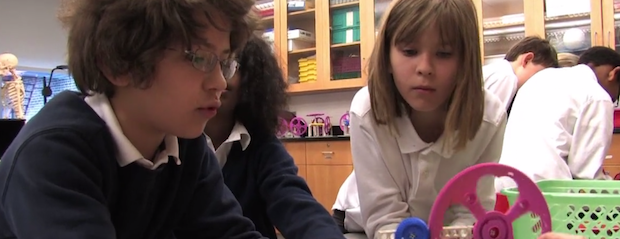Elementary students trying to figure out how a salad spinner works.
It is not every day that one encounters three aspiring scientists sitting side by side in the school cafeteria, but that is exactly what happened to me the week before vacation. Overhearing a group of sixth graders talking about “sciences de la vie et de la terre”, I stopped to wish them luck on what I thought was a test they were about to take. It turned out that they were simply discussing science, and doing so with passion, because they found it inspiring.
Are any of you thinking about becoming a scientist later in life, I asked? All three raised their hands. So what makes you so fascinated by this subject, I continued, pulling up a chair. I like knowing how the world works, especially outer space, replied one. Me too, a second classmate agreed, adding something like: lots of times, when we look at nature, we just take everything for granted, but I love seeing what’s under the surface. For me, our third student interjected, I want to become a scientist because I would like to find a cure for Ebola and I am sure we can.
To explore: the best way to learn
Of course, the educator in me wants to attribute at least part of this impressive motivation to our students’ first experience of science in our primary program, where all three had been educated. As elementary school parents will know, our science curriculum in the earliest years is framed entirely in terms of experiential, inquiry-based learning. Students are taught to develop a mindset and skills which lead them to look at the world around them as something which is both calling out and able to be discovered. They learn that being a scientist means first and foremost being an explorer. In many respects, the name of our science program speaks for itself: “la main à la pâte”, a French expression which translated into English means “one’s hands in the dough” and suggests that true, lasting learning takes place when one rolls up one’s sleeves and engages directly with the topic being studied rather than by standing back and memorizing information.
“Inspiring imaginations, opening perspectives“
Established in 1996 by French recipient of the Nobel Prize in Physics Professor Georges Charpak, this curriculum aims to «provide an experience of science as a means of personal reflection…of science as a source of questioning, observing, inquiring, arguing and expressing oneself, rather than as a pretext for accumulating knowledge…of science as something which inspires the imagination, opens perspectives to infinite panoramas and in so doing allows the mind to breathe to its fullest potential.”* At the Lycée Français de New York, as you will see for yourselves in the video below, we have embraced this perspective with tireless dedication. And based on my lunchtime conversation with our middle school students, that commitment seems to be yielding fruit.
Dear students, I went on, may I recommend a little reading to you, if you can find the time in your very busy schedules? Yes sir, came their enthusiastic reply. Well, when you have a chance, one book I think you will really like is Letters to a Young Scientist by someone called Edward O. Wilson. Professor Wilson taught generations of students at Harvard and what he has to say to young scientists like yourselves is very exciting: to be a scientist you do NOT have to be a genius in math or for that matter in biology, physics or chemistry, despite what many people think. All you need, says Professor Wilson, is a deep curiosity about the world. And from the sound of it, you three have an abundance of that curiosity. Bravo. Letters to a Young Scientist. Edward O. Wilson. Have a look!
*Georges Charpak, Pierre Lena, Yves Quere et Edith Saltiel, L’Enfant et la science: l’aventure de La main à la pâte (Paris: Odile Jacob, 2005 ; translation by Sean Lynch), page 9.
About the Author :
Sean Lynch was Head of School at the Lycée Français de New York from 2011 to 2018, after having spent 15 years at another French bilingual school outside of Paris: the Lycée International de St. Germain-en-Laye. Holding both French and American nationalities, educated in France (Sciences Po Paris) and the United States (Yale), and as the proud husband of a French-American spouse and father of two French-American daughters, Sean Lynch has spent his entire professional and personal life at the junction between the languages, cultures and educational systems of France and the United States. In addition to being passionate about education, he loves everything related to the mountains, particularly the Parc National du Mercantour.


